 Earlier this month I turned on the first of what I hope will be many “hyperlocal” deployments of the Swara platform at Jan Swasthya Sahyog in Ganiyari village, just outside Bilaspur in Chhatisgarh (Central India).The platform will be used by the community health workers associated with JSS, to record health related information from the field using their mobile phones.
Earlier this month I turned on the first of what I hope will be many “hyperlocal” deployments of the Swara platform at Jan Swasthya Sahyog in Ganiyari village, just outside Bilaspur in Chhatisgarh (Central India).The platform will be used by the community health workers associated with JSS, to record health related information from the field using their mobile phones.I had heard stories of the fantastic work that JSS is doing in the area of rural medicine, working directly with some of India’s poorest communities, so I was thrilled when Surajit Nundy and Daniel Pepper invited me to visit the facility in Ganiyari. Daniel and Surajit have been working with a committed group of technical volunteers to create an open source electronic medical records system (EMR) to be used at JSS.
One of the reasons for my visit was to work out how we could link the Swara IVR system to the EMR to facilitate voice access for community users.
The JSS facility is unlike any other hospital I have ever been to. It combines modern excellence with typical Indian efficiency in a rather unique way. Daniel gave me the tour of the premises and I was impressed to see the level of medical care that the hospital is equipped to provide, particularly given the fact that they are located in a rural area, with limited infrastructure and access to resources.
Dr Ramani, one of the senior doctors at JSS, later told me that the facility has backup power to supplement the government supply and even during extended power cuts the operating theater always retains power.
Even more amazing than the facility are the doctors themselves. The doctors at JSS are all highly qualified professionals, who could be earning without exaggeration in the millions of dollars.
However, they have chosen to place themselves in the service of the poor.
Speaking to the doctors and senior community health workers, it appeared that one of the primary challenges faced at the facility was documentation and collection of statistical data.
The community health workers typically call in births, deaths, pregnancy information and other relevant health data. The calls were so far being received by human operators. This required someone to be present at a telephone with pen and paper to accurately record what the community health worker was saying. If the recipient of the call happened to be in transit or could not write down the information for some reason, the data could be lost for ever, since the community health worker may or may not recall it at the monthly meetings.
As this appeared to be a perfect use case, we decided to set up the standard Swara platform with the familiar “press 1 to record, press 2 to listen” interface, with just the LoudBlog management interface on the web side.
The Matrix SETU ATA211G would provide the GSM connectivity, via a local SIM card.
This would provide a phone number where the community health workers would call in and using the IVR interface, record birth, death and pregnancy information to start with.
For example, a birth report could include the child’s parents name, weight at birth and vital signs, while a death report might include name, age, cause of death and so forth. JSS community health workers could then transcribe this information and it would be filed in a database for later reference and visualization.
JSS already has a program in place to at least partially reimburse the community health workers for their phone calls so paying for the local calls would not be a concern (or a running cost 🙂 )
The setup was fairly trivial, we used a VirtualBox VM running Fedora 16 to set the Swara server up and Praful ji, one of the senior community health workers lent his voice for the new IVR prompts in Chhattisgarhi.
We spent some time with the community health workers as well, explaining the use of the system. Obviously one session does not do much in the way of training people to use voice portals. Even so, we did get a positive response from the health workers as they could see that recording data this way would save them significant time and effort while providing a more reliable channel for data than the present one.
The doctors and the senior health workers at JSS will next be formulating a training plan and circulating the number with a few health workers at a time, to grow the community at a manageable pace.
If the initial use case shows promising results, there are several more areas where IVR and voice interfaces can be used. Some of the ideas that we threw around at our brainstorming session with Dr. Yogesh Jain were using audio prescriptions that patients can access on their phone and a medical Q&A service where people can leave their minor health queries in audio form, which experts can then answer, also in speech.
This sort of innovation could lead to a revolution in primary healthcare in rural areas where literacy and infrastructure are both at a premium. Once the Open Source EMR system goes online, the IVR system could also link to it directly.
I will be watching the JSS deployment closely and will post updates on this blog as they happen.
